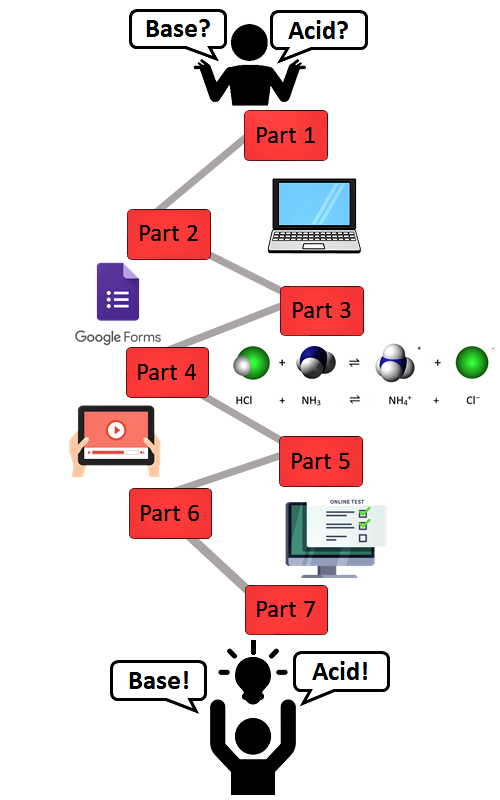The effects of online learning about the Brønsted-Lowry theory of acids and bases in the first grade of grammar school during the COVID-19 pandemic Scientific paper
Main Article Content
Abstract
The aim of this paper was to examine the effects of the application of online material on the Brønsted-Lowry theory of acids and bases on the active construction of knowledge in first-grade grammar school students during the COVID-19 pandemic. The online material was designed to enable students: (a) to learn the teaching material in smaller parts; (b) to assess the acquired knowledge after each part of the teaching material; (c) to progress through the lesson at their own pace; (d) to visualise and interrelate the macroscopic, submicroscopic and symbolic representations of the contents about acids and bases by using a video recording and illustrations; (e) to re-examine the accuracy of the given answers. The research sample consisted of 122 first-grade grammar school students, who learnt about the Brønsted-Lowry theory for the first time. The instruments used in this research study were two tests (a pre-test and a post-test), the validity of which was examined by two university professors and two grammar school chemistry teachers. The applied approach enabled the active construction of knowledge in the majority of students, while it provided the teachers with an insight into the progress and outcomes of the process.
Downloads
Metrics
Article Details

This work is licensed under a Creative Commons Attribution 4.0 International License.

Authors retain copyright and grant the journal right of first publication with the work simultaneously licensed under a Creative Commons Attribution license 4.0 that allows others to share the work with an acknowledgement of the work's authorship and initial publication in this journal.
Funding data
-
Ministarstvo Prosvete, Nauke i Tehnološkog Razvoja
Grant numbers 451-03-47/2023-01/200168
References
A. Pardino, I. Gleyzer, I. Javed, J. Reid-Hector, A. Heuer, Creat. Educ. 9 (2018) 1123 (https://doi.org/10.4236/ce.2018.97083)
T. Russell, The No Significant Difference Phenomenon: As reported in 355 research reports, summaries, and papers, 5th edn. IDECC, North Carolina State University, 2001
C. Cavanaugh, K. J. Gillan, J. Kromrey, M. Hess, R. Blomeyer, The effects of distance education on K-12 student outcomes: a meta-analysis. Learning Point Associates/North Central Regional Educational Laboratory, 2004
N. Jahng, D. H. Krug, Z. Zhang, The European Journal of Open, Distance and E-Learning 10 (2007) (https://old.eurodl.org/materials/contrib/2007/Jahng_Krug_Zhang.pdf)
M. Allen, J. Bourhis, N. Burrell, E. Mabry, Am. J. Distance Educ. 16 (2002) 83 (https://doi.org/10.1207/S15389286AJDE1602_3)
A. Driscoll, K. Jicha, A. N. Hunt, L. Tichavsky, G. Thompson, Teach. Sociol. 40 (2012) 312 (https://doi.org/10.1177/0092055X12446624)
Y. Zhao, J. Lei, B. Y. C. Lai, H. S. Tan, Teach. Coll. Rec. 107 (2005) 1836 (https://doi.org/10.1111/j.1467-9620.2005.00544.x)
M. Shachar, Y. Neumann, Int. Rev. Res. in Open Dis. Learn. 4 (2003) 1 (https://doi.org/10.19173/irrodl.v4i2.153)
M. Allen, E. Mabry, M. Mattrey, J. Bourhis, S. Titsworth, N. Burrell, J. Commun. 54 (2004) 402 (https://doi.org/10.1111/j.1460-2466.2004.tb02636.x)
R. A. Tigaa, S. L. Sonawane, J. Chem. Educ. 97 (2020) 3318 (https://doi.org/10.1021/acs.jchemed.0c00554)
S. S. Jaggars, Am. J. Distance Educ. 28 (2014) 27 (https://doi.org/10.1080/08923647.2014.867697)
I. J. Rhile, J. Chem. Educ. 97 (2020) 2857 (https://doi.org/10.1021/acs.jchemed.0c00618)
S. L. Williams, Am. J. Distance Educ. 20 (2006) 127 (https://doi.org/10.1207/s15389286ajde2003_2)
R. M. Bernard, P. C. Abrami, Y. Lou, E. Borokhovski, A. Wade, L. Wozney, P. A. Wallet, M. Fiset, B. Huang, Rev. Educ. Res. 74 (2004) 379 (https://doi.org/10.3102/00346543074003379)
K. Swan, Learning effectiveness: what the research tells us, in J. Bourne, J. C. Moore (Eds) Elements of Quality Online Education, Practice and Direction. Needham, MA: Sloan Center for Online Education, 2003, pp.13-45
J. G. Nguyen, K. J. Keuseman, J. J. Humston, J. Chem. Educ. 97 (2020) 3429 (https://doi.org/10.1021/acs.jchemed.0c00790)
H. T. Nennig, K. L. Idárraga, L. D. Salzer, A. Bleske-Rechek, R. M. Theisen, Chem. Educ. Res. Pract. 21 (2020) 168 (https://doi.org/10.1039/C9RP00112C)
Z. Qiang, A. G. Obando, Y. Chen, C. Ye, J. Chem. Educ. 97 (2020) 3446 (https://doi.org/10.1021/acs.jchemed.0c00609)
E. K. Faulconer, J. C. Griffith, B. L. Wood, S. Acharyya, D. L. Roberts, Chem. Educ. Res. Prac. 19 (2018) 392 (https://doi.org/10.1039/C7RP00173H)
J. F. Eichler, J. Peeples, J. Chem. Educ. 90 (2013) 1137. (https://doi.org/10.1021/ed3006264)
D. Šišović, S. Bojović, Nastava i vaspitanje. 50 (2001) 185 (https://scindeks.ceon.rs/article.aspx?artid=0547-33300102185S)
S. H. Paik, J. Chem. Educ. 92 (2015) 1484 (https://doi.org/10.1021/ed500891w).





